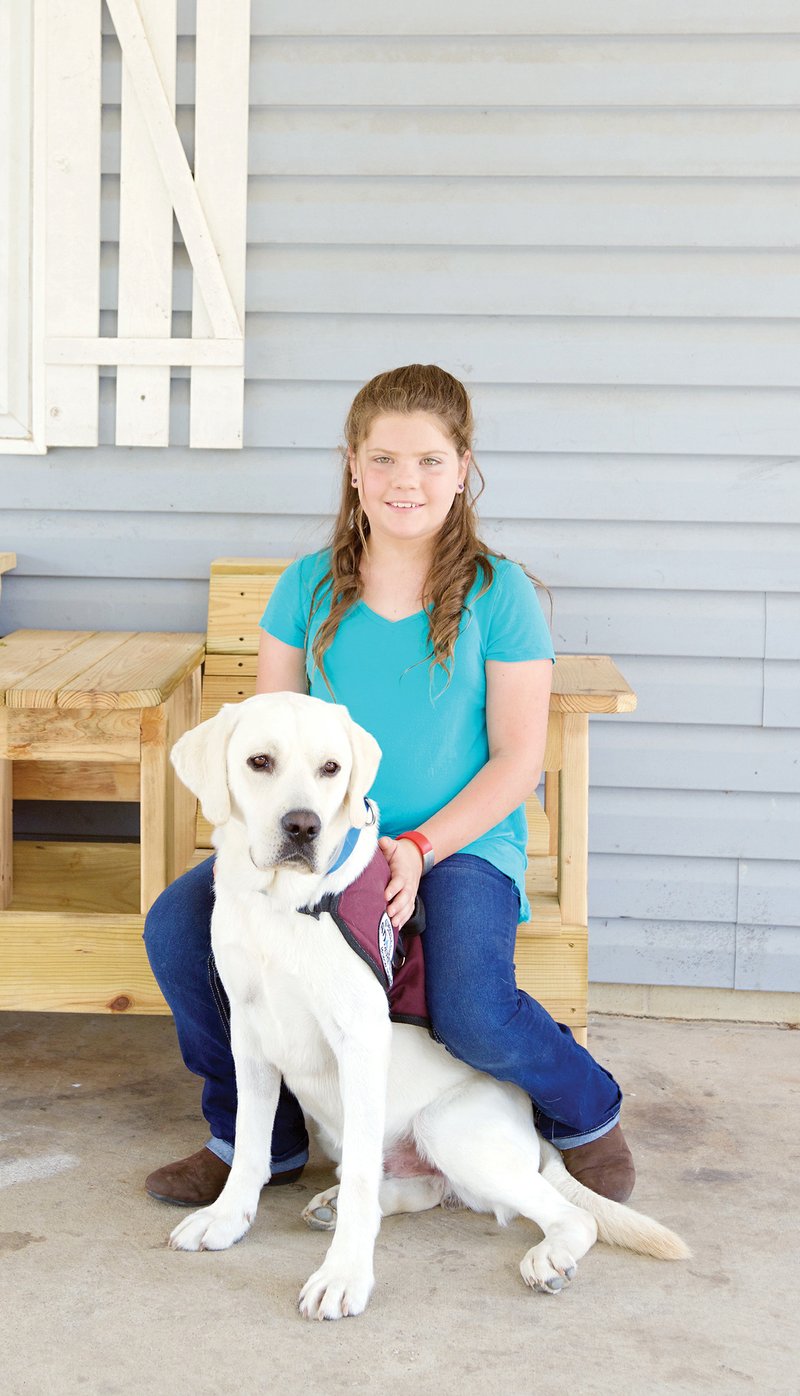Many nights, Sunnie Simpson has feared sleeping alone. As a Type 1 diabetic, she becomes sweaty and pale when her blood sugar is too low, and incredibly thirsty when it’s too high. What is perhaps most troublesome is that during these lows — her blood sugar once dropped to an alarming 42 — she struggles with waking up and sometimes doesn’t do so until at a hospital.
Now that Sunnie, 10, has a diabetic-alert dog, the girl has both a resource and a relief.
In March 2016, Brandi Simpson, Sunnie’s mother, began a $25,000 fundraising campaign so Sunnie could receive a diabetic-alert dog through Service Dogs by Warren Retrievers. SDWR, a nonprofit based in Madison, Virginia, trains and provides service dogs for those with post-traumatic stress disorder, seizure disorders, diabetes and autism. Diabetic-alert dogs are able to detect highs and lows in a client’s blood sugar, retrieve food and medication, and contact 911 on specialized devices.
Brandi said she sought SDWR because of its responsiveness to her inquiry, honesty and the fact that someone as young as Sunnie could receive a dog. The family received Bentley, a playful 16-month-old white Labrador, about a month ago.
Bentley smells the differences in Sunnie’s blood-sugar levels and taps either Sunnie or her mother on the leg with his paw to alert them, helping Sunnie to maintain normal blood glucose levels between 80 and 180 milligrams per deciliter.
“When [her blood sugar is high, she] gives out a citrus smell. When [the readings are] low, [diabetics] put out a fruity smell in their breath,” Brandi said. “He can sense it. It was amazing. The first night we had him, he alerted three times.”
Within three weeks of Bentley being in the home, he had alerted the family about 170 times, Brandi estimated.
“They have a very great bond. The closer the bond is, the better he’ll alert more often,” Brandi said.
Sunnie was diagnosed with Type 1 diabetes at age 2 1/2 and, according to the American Diabetes Association, is one of more than 360,000 Arkansans with a form of diabetes. According to the JDRF, formerly known as the Juvenile Diabetes Research Fund, Type 1 diabetes is an “autoimmune disease in which a person’s pancreas stops producing insulin,” a hormone that helps people get energy through food. There is no cure for the disease.
“It’s a lot of work,” Sunnie said of treating her diabetes. “You have to check your blood sugar a lot.”
Sunnie checks her blood sugar an average of 13 times a day and takes an insulin shot in the arm, leg, stomach or back whenever she needs to eat. To fall asleep at night, she often wants her mother to lie with her, as Sunnie often fears that a change in her blood sugar overnight will keep her from waking up.
On a recent night, Bentley kept his face in Sunnie’s until she woke up, Brandi said, and he’ll alert Brandi during the night if Sunnie is having trouble waking.
SDWR dogs are trained beginning at 7 weeks. Once a dog is 4 months old, it begins training with the organization’s service-dog raisers, who keep the dog until it’s 9 to 18 months so it can be exposed to everyday encounters an individual would have, such as with a bus or a vacuum cleaner. Once a dog meets its new family, an SDWR trainer helps customize that dog’s training to its handler’s needs.
For Bentley, Sunnie’s main need is to be alerted for blood-sugar checks. After Bentley alerts her with a tap of his paw, Sunnie will prick her finger with her blood-glucose monitoring machine and test her level. She lets Bentley smell or lick the remaining blood on her finger and treats him for his alert. Sunnie gets a treat, too, Brandi said.
“The thing is, if you treat her, you treat him. If you don’t treat her, you don’t treat him,” the mom said. “If [her blood sugar is] high, she has to take insulin; if she’s low, she gets a snack.”
Family members are teaching Bentley to use his nose, instead of his paw, to alert them of lows in Sunnie’s blood sugar.
“Right now, he does the paw for both,” Brandi said.
Every three to four months over an 18-month period, an SDWR trainer will return to help the family and dog progress in training efforts. When a trainer returns this winter, Bentley will learn to use a specialized device to press a button that will call 911 when Sunnie isn’t waking up as a result of drastic dips or highs in her blood sugar. That training will become more of a need when Sunnie is old enough to stay home alone, or at about 14 or 15 years old, Brandi said.
Though he hasn’t begun attending school with Sunnie yet, Bentley has been well-behaved and well-liked as the family goes to the grocery store, the mall, pet stores and other public places. Brandi said she owes thanks to her friends who helped manage her fundraising efforts and to a local flakeboard manufacturer that covered the family’s remaining $13,000 need last November.
Having Bentley is an added comfort and companion in the Simpson home as the family copes with Sunnie taking her daily treatments.
“She’ll have to do that for the rest of her life until they find a cure,” Brandi said. “They haven’t yet, but one day they might, but until then, we’ve got him. He does an amazing job.”
For more information on Service Dogs by Warren Retrievers, visit www.sdwr.org.
